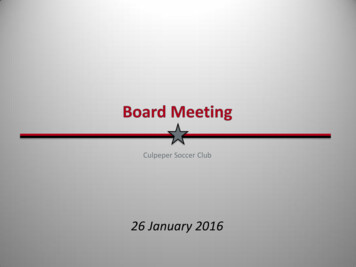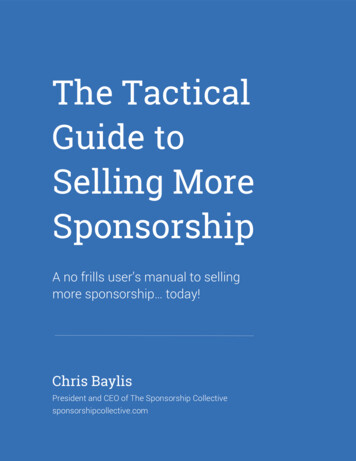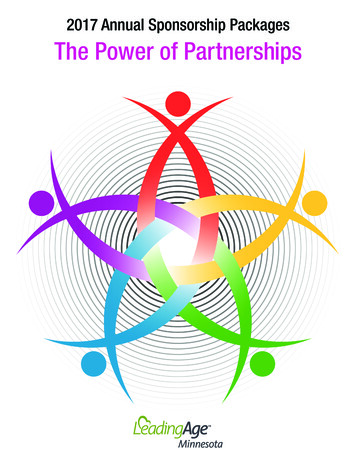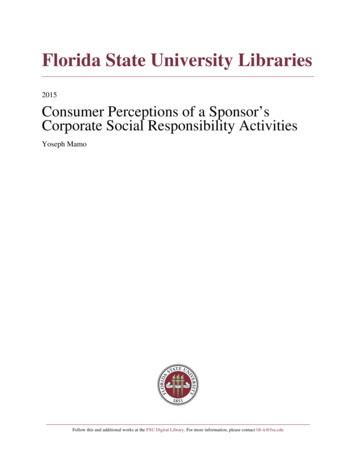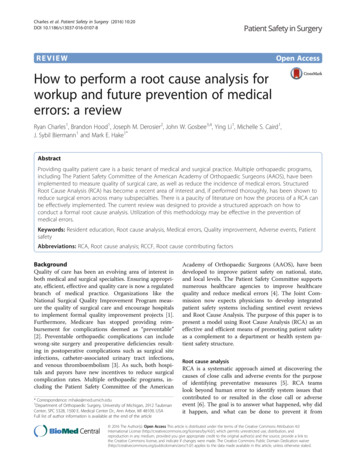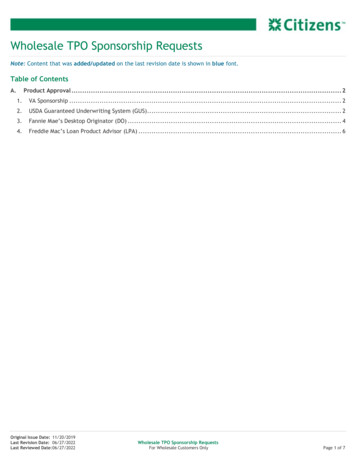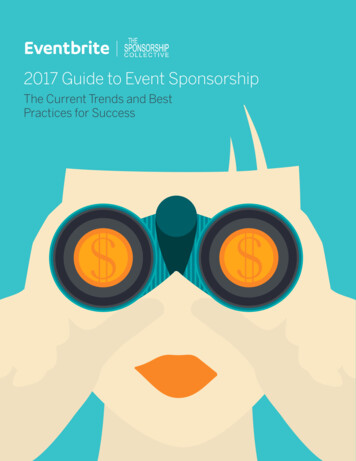
Transcription
2017 Guide to Event SponsorshipThe Current Trends and BestPractices for Success
ContentsIntroduction03The New Paradigm of Event Sponsorship05The Secret Weapon of B2B Events09Creating Sponsorship Opportunities12Determining Your Value14Menus Win Sponsorship, Not Packages17Don't Email Your Proposal19Closing Next Year’s Sponsors Today23One Thing You Must Do to WinSponsorship in 201727The Takeaway29Eventbrite.com/blog 2017 Guide to Event SponsorshipPage 2
The online world has connected brands to customersin new ways, but your event can give them somethingdigital advertising can't — unprecedented access totheir customers.In return for that access, sponsors are willing to paylarge sums of money — up to 62.8 billion in fact.According to IEG's 2017 report on "What SponsorsWant," sponsorship spending in North America isexpected to grow faster than other forms of marketingand advertising.Meet the expertsChris BaylisPresident and CEOof The Sponsorship CollectiveSara BerryVice President Partnerships andMarketing for Boston CannonsJoe WatersFounder & Blogger, Selfish GivingLarry WeilPresident of The Sponsorship Guy JoJo GutfarbVice President of Goodwin Group PRKatie O’NeilSenior Corporate Events Manager forLogMeInEventbrite.com/blog 2017 Guide to Event SponsorshipPage 3
A guide for ambitious event professionalsThis guide is for event professionals who are runninglarge-scale events and want to future proof their abilityto win and retain sponsors. You know that sponsors addan important revenue stream to your event and help youdeliver enormous value to your attendees.What you'll learn: Why gold, silver, and bronze packages are the most overrated tool The secret, sponsorship-winning weapon of B2B events How to correctly determine the value of your sponsorship assets And so much more But first, let’s take a moment to talk about the newparadigm of event sponsorship.Eventbrite.com/blog 2017 Guide to Event SponsorshipPage 4
The New Paradigm of Event SponsorshipWhat is sponsorship?If you're having difficulty answering that question, you're in goodcompany."It used to be a pretty simple answer," says Larry Weil. Larry is theSponsorship Guy. And with nearly two decades of experience and over4,000 brand and industry contacts, it's a title he's proudly earned."Most people think of sports sponsorships like McDonald’s and the U.S.Olympic team, or Bud Light and the NFL. But there's much more to itthan that."On the surface, sponsorship is a highly specialized branch ofadvertising and marketing, connecting brands to their customers.But as Larry Weil said already, there's much more to it than that.In a recent survey, event professionals were asked to rank theirsponsorship challenges from least to greatest. The results seem tosuggest an answer to why so many professionals, the experts included,have a hard time defining sponsorship succinctly.Respondents said that securing sponsors for their event was just asdifficult as finding them — which was only marginally more difficultthan approaching sponsors and measuring and evaluating sponsorshipreturn on investment (ROI).The emerging pattern in these responses show that events aren’tstruggling with any single aspect of event sponsorship — it’s theentire process.Eventbrite.com/blog 2017 Guide to Event SponsorshipPage 5
Respondents of a recent survey saidfinding and securing sponsors weretheir greatest challenge.Finding sponsorsApproaching sponsorsSecuring sponsorsActivating sponsorshipMeasuring sponsor ROIRetaining sponsors012345678910"Digital advertising has changed things," says Joe Waters of SelfishGiving. He spends his time helping nonprofits secure corporatesponsors and speaks with a wicked Boston accent. "The abundanceof data and analytics in the digital world has greatly influenced howsponsors measure success in the real world.""When I started in the industry, smartphones and social mediaplatforms were just coming into play," says Katie O’Neil, who’s workedon events like HubSpot’s Inbound and is now the Senior CorporateEvents Manager for LogMeIn. "There are so many more ways for anevent sponsor to interact with their event attendees now."Eventbrite.com/blog 2017 Guide to Event SponsorshipPage 6
Sponsorship Collective president and CEO Chris Baylis calls this shifta new paradigm for event sponsorship. “In order to build a foundationand successfully win sponsors, events need to change theirperspective,” he says.“While there are still aspects of sponsorship focused on brandawareness, there's a new paradigm for event sponsorship,” he says.“Today's customers know when they’re being advertised to and canmore easily ignore marketing messages.”For that reason, Baylis explains, “sponsors don't just want yourattendees to be aware of their product or service. They want to offervalue, provide solutions, and create deeper, long-lasting connectionswith your attendees.”Sara Berry has sold sponsorship for multiple properties, includingrestaurant guide Zagat, the New England Patriots, and — most recently— the Boston Cannons. She rarely uses the word “sponsorship”anymore. “It’s much more of a partnership these days,” says Berry.“Successful sponsorship happens when sponsors and events worktogether to advance one another’s goals.”A possible reason sponsors and events are pressured to hold oneanother accountable, according to most of our experts, is tightercorporate budgets.When budgets get tight, sponsors scrutinize every opportunity. Andwhen a sponsor can easily raise awareness for their brand on digitaland social media, often at a more affordable price and with ROI that'seasier to prove, it’s no surprise that awareness is no longer the solepurpose of sponsorship.Accustomed to the real-time feedback and data-rich reporting in thedigital world, sponsors demand a new paradigm for sponsorship in thereal world.Eventbrite.com/blog 2017 Guide to Event SponsorshipPage 7
So what do sponsors want?Sponsorobjectives& goalsEventsponsorshipAttendeeneeds, wants,& desiresSponsorships give brands a lucrative opportunity — to meet theircustomers in person. But in the new paradigm of event sponsorship,access isn’t enough.“It comes down to knowing your event,” says Katie O’Neil. “There aretoo many events offering the same access to the same sponsors. If youwant to win sponsorship today, you’re going to have to know who yourattendees are and how sponsors can help them.”Eventbrite.com/blog 2017 Guide to Event SponsorshipPage 8
The Secret Weapon of B2B EventsBusiness-related events — like conferences, summits, and trade shows— have a distinct advantage over B2C events like sports games ormusic festivals.Spoiler alert: it's your attendees."Sponsorship has increasingly become an integral part of the businessworld," says JoJo Gutfarb, vice president of Goodwin Group PR.In comparison to concert-goers, sports fans, and festival die-hards,people who attend B2B events make important business decisions andcontrol corporate budgets. According to Chris Baylis, these attendeescan be 10 to 100 more valuable than the general public."B2B events have more layers to them, which means there’s moreopportunity for sponsorship," says Joe Waters. "At a conference, forexample, not only can sponsors get on stage and directly address theaudience, but they can have face-to-face conversations with their mostinterested customers."With that in mind, knowing why people attend your event and theproblems they are experiencing in their professional lives can help youcreate valuable sponsorship opportunities."The attendee list is the first thing I look at when evaluatingsponsorship opportunities for LogMeIn," says Katie O'Neil. "If I’mconfident that we’ll be able to reach our target audience, I’ll considerthe opportunity — but only then.”Eventbrite.com/blog 2017 Guide to Event SponsorshipPage 9
Who are your attendees? Just ask them.It's not enough to tell potential sponsors that your event attracts aB2B audience. If you hope to utilize your secret weapon, you'll need toknow who your attendees are before you can determine their value tosponsors.If you use Google Analytics to track your event website or listing, you'llbe able to gather basic demographic data about your attendees. Thenwith a data management platform like Umbel, you can combine thedata from Google Analytics and your ticketing and registration systemwith their third-party data. Now you know things like household income,purchase behavior, and a lot more.Are your events on Eventbrite?PROTIPSAdd Google Analytics to your event listings so you can track visits toyour event pages. Combined with your event reports and analytics, youwill have holistic view of who’s interested in your event — not justwho’s attended.Thanks to free web analytic tools and inexpensive databases, it's rathereasy to collect basic demographic and firmographic data about yourattendees. Because it's both affordable and effortless to gather thisdata, you can safely bet your competition has an easy time getting toknow their attendees.Eventbrite.com/blog 2017 Guide to Event SponsorshipPage 10
Which is why, to remain competitive, you must go deeper.From purchasing market research to analyzing your attendee data,there are numerous ways to define your attendees — but the bestmethod is surveying. Surveys allow you to go deeper by asking yourattendees about their frustrations, goals, budget responsibilities, andother information potential sponsors will find valuable.In addition to basic questions about your attendee's age and jobfunction, find out how many people they manage and if their team isnational or global. Consider asking them how long they've worked intheir industry. Have them tell you their greatest challenges.It's worth noting, though, that you'll want to limit the amount ofquestions on your registration form. Studies show that each step in thepurchase process can lead to a 10% decrease in sales. So ask only themost important questions upfront, then save the rest for a post-eventsurvey.Once you know your attendees better than you ever have before, lookfor common traits and characteristics they share — and don't stop untilyou've identified at least three or four.Avoid using a single trait or characteristic to define your audience.For example, let’s say your event attracts software engineers. Thatalone isn’t enough to woo sponsors. Sponsors will want to know theirseniority, company size, and area of expertise."Brands divide their customers up by segments to help themadvertise more cost effectively," says Chris Baylis. "As Joe Waters saidearlier, they expect the same level of detail from events seeking theirsponsorship. So the more you can segment your audience, the betterprepared you'll be to win sponsorship."Eventbrite.com/blog 2017 Guide to Event SponsorshipPage 11
Creating Sponsorship OpportunitiesIn an earlier section, you learned that brands sponsor events togain access to their target audience. The next step in securing eventsponsorship is determining how sponsors will interact with yourattendees.Respondents of a recent survey say their ability toidentify sponsorship assets is mostly average.Very poorPoorAverageGoodVery goodI don't know0%50%100%In our survey, many respondents consider their ability to identify eventassets for sponsorship to be average. If you’re among that group, thissection demystifies the process.Eventbrite.com/blog 2017 Guide to Event SponsorshipPage 12
So what is an asset?A logo placement, for example, is an asset. So are speakingopportunities or complimentary passes. But if you’ve taken the time tolearn who your attendees are, you’ll be able to identify more valuableassets.Let's say a large number respondents to a post-event survey from lastyear mentioned wishing there were more networking opportunities atyour single-track conference. You want to fulfill their wishes, but youonly budgeted for one cocktail mixer. This is the perfect opportunity fora sponsor — and a valuable asset, too.Gather your team for a brainstorm and see how many assets you cancome up with. If you need inspiration, Joe Waters from Selfish Givingrecommends keeping an eye on the competition. "A lot of people don'tlook at similar events to see how they’re doing sponsorships, but theydefinitely should," he says. "Look at other events and see if they'remaking money off something you're not."As you develop your list of assets, create a table, listing each asset inthe first column. Your next task is to assign a value to each, which we’llexplain in the next section.If you’re using Eventbrite for registration, you can create custom,hidden tickets for sponsors quickly and easily.PROTIPSEventbrite.com/blog 2017 Guide to Event SponsorshipPage 13
Determining Your ValueOnce you have a list of assets available for sponsorship, the nextstep in the process is to determine how much you'll charge for eachopportunity.This part of the process is called valuation. And according to ChrisBaylis, a lot of events get this part wrong. "A majority of eventorganizers have no idea what the market rate is for their sponsorshipproperties," he says. "So they tend to make up their value."This method may help you win a handful of sponsorships, but in realitycould leave money on the table. "By blindly assigning value to yourassets, you can undercharge sponsors or ask for too much," saysBaylis.Our sponsorship experts agreed that asset valuation should be basedon value."It really comes down to how valuable that asset is to the sponsor,"says Larry Weil. "Sponsors will spend money on anything that improvestheir business. So long as you can prove a return on their investment,the only barrier will be their budget."To maximize your sponsorship revenues and — if you manage yourcosts appropriately — your profits, you'll need to find the sweet spotbetween the actual cost of each asset and the perceived value of it.Eventbrite.com/blog 2017 Guide to Event SponsorshipPage 14
According to Weil, most events stop somewhere after the firststep in that process. “In my experience, too many events price theirsponsorships at or around cost,” he says. “For example, they willcharge 250,000 to sponsor the post-event cocktail party becausethat’s how much it cost. They ignore the dollar value of theopportunity to the sponsor.”If your sponsor's perceived value is higher than your activation price,then they will decide to sponsor. And if your cost for activation is lowerthan that price, you will make money.Value-based pricing modelPerceived valueWhy a brand sponsorsyour eventPriceYour marginCostNot only is this method the best long-run economic model for yourevent, value-based pricing helps you approach event sponsorship morelike a partnership. Instead of being concerned about your profit margin,you'll be focused on delivering on the perceived value.You'll start by researching the market rate for your assets — whichmeans looking at your competition. "Seeing what other events chargefor similar sponsorship opportunities is a common method fordetermining your price," says Joe Waters.Eventbrite.com/blog 2017 Guide to Event SponsorshipPage 15
Gather as many reference points as possible and take detailed notesabout their value proposition — it'll come in handy later. "When youlook at other events, don’t just look at what they're charging sponsors,"adds Waters. "Look at what they’re offering them for that price!"Also, keep in mind that you’re also competing with other methods ofadvertising. Potential sponsors are investing money in advertising andmarketing on a daily basis. They know exactly how much an email blastor logo placement is worth — you should, too.Once you have enough to data to determine the market rate for yoursponsorship assets, put yourself in your sponsor's shoes. What will theyget out of this opportunity? Sponsorship is a business investment, andsponsors need to see a tangible outcome before they'll meet with you,much less commit.With deep knowledge about your attendees, look back at your marketresearch and analyze how competitors position their sponsorships.Are there ways to promise more value? For instance, if your attendeesurvey revealed that an overwhelming majority of them were the finaldecision maker on budget decisions, your assets may be more valuableto sponsors.Now you'll set the initial price of your assets.If you're worried about getting it wrong, don't. Setting the initial pricefor your assets can be tricky. No one guesses the “perfect” price ontheir first go. Even with all of the best research in the world, you willbe much better served if you treat pricing as a test-and-then-iterateexercise — an exercise of constant learning and adaptation."It's all trial and error," says Sara Berry. "You need confidence going in.Once you start talking to sponsors, you'll become more familiar withtheir goals and objectives." And eventually, you'll determine the truevalue of your sponsorship assets.Eventbrite.com/blog 2017 Guide to Event SponsorshipPage 16
Menus Win Sponsorship, Not PackagesThe work you'll have completed by following the best practicesmentioned so far will help you create lucrative sponsorshipopportunities. But before you start contacting your prospects, you'llwant to consider parting ways with a longstanding tradition: tieredsponsorship packages.Most of our experts believe that gold, silver, and bronze sponsorshippackages — or any naming scheme — can be effective conversationstarters. But they all wholeheartedly agree that custom packages arekey to discovering bigger, more valuable opportunities that sponsorsreally want.Chris Baylis thinks they should be done away with entirely: "So mucheffort is put into crafting a sponsorship package. Yet it is the mostoverrated, unnecessary tool in your tool box."Larry Weil doesn't feel as strongly. "In some industries, packages work,"he says. "For some events, it’s what people have grown to expect. But ifyou’re in a new, innovative space with lots of variables — don’t do it."The likelihood that you'll have the perfect mix of assetsto fit the sponsor's business objectives is effectively zero.—Chris Baylis, President and CEO of Sponsorship CollectiveEventbrite.com/blog 2017 Guide to Event SponsorshipPage 17
Sponsors don't want to buy a bunch of assets they don't need. Forcingthem to choose between arbitrary levels may mean you're leavingmoney on the table. Instead of offering prospects packages, give thema menu of assets to choose from.This can lead to bigger sponsorship deals and longer lastingpartnerships with valuable sponsors. List your sponsorship assets byactivation type — branding, on site, samples, experiential — to helpsponsors quickly understand the potential value of each asset.And if you absolutely must create tiered sponsorship packages, JoJoGutfarb emphasizes, "Let sponsors know you can create somethingexclusive for them. If you don't, you're throwing money away."When it comes to including prices, most of our experts agreed thatassociating values to your assets can be helpful for sponsors. As KatieO'Neil puts it, "Assigned values provide a baseline and let the sponsorknow if the opportunity is feasible to their budget."But Chris Baylis advises that you skip it. "When you truly understandyour attendees and have created sponsorship opportunities thatperfectly align with your prospect's objectives, a menu will open thedoor to sponsors," he says. "Leaving the price off forces them tocontact you."Eventbrite.com/blog 2017 Guide to Event SponsorshipPage 18
Don't Email Your ProposalNearly half of survey respondents say their primary method forcontacting sponsors is email. If you're amongst the majority, thesponsorship experts say that you should never lead with a proposal orpackage."Your proposal is like a resume," explains Larry Weil. "No one submitstheir resume to an employer expecting the hiring manager to call themback saying they’ve got the job. It's an iterative process, much likesponsorship. It takes time to build a relationship and get commitment."The experts also say to avoid mass emails (or e-blasts). “One of themost common mistakes I see people make is sending 600-word emailswith a proposal attached,” says Baylis. “They hope the recipient willopen, read, and respond by purchasing a prepackagedopportunity— it doesn’t work like that.”When is it okay to send your proposal? "After the sponsor explicitlyasks for one and you know enough about their goals to create a custompackage," says Baylis.The iterative process of approaching sponsors begins with identifyingthe decision maker. You can accomplish this a number of different ways.Attending an event your potential partner is sponsoring, for example, isa great way for you to make connections. Social media is another goodchannel for reaching out to a potential sponsor.In the following sections, you'll learn how to approach sponsors,measure your progress, and make the best of each meeting.Eventbrite.com/blog 2017 Guide to Event SponsorshipPage 19
Approach with brevityAs you begin to approach potential sponsors, remember that your goalis not to sell sponsorship — it's to find the decision maker and ask for ameeting after your do.Keep your messages to two or three brief sentences and demonstrateinterest in their goals and challenges.The examples below demonstrate how to find the decision makerand ask for a meeting. Although they're presented here as emails, youcan easily use them to guide your conversations on social mediaor in person.The follow up/warm emailHey there,This email sample shows how you wouldfollow up with a connection made at anevent. Instead of leading with the proposal,take the time to gather information andlearn who’s who at the company.It was great to meet you last week at theXYZ event. Any chance you can suggestthe best contact for those in the product Xside at your company?Thanks,Your NameThe cold emailHey there,If you're not fortunate enough to make awarm connection first, going in cold shouldn'tbe a problem with this sample email. Keep itbrief, and offer a date and time — that wayyou're asking them which time works forthem, not if they want to meet you or not.I saw on LinkedIn that you are involved in(related product/project), I would love toconnect and ask your thoughts about acool project I'm working on.Are you free tomorrow at 3:00?Your NameEventbrite.com/blog 2017 Guide to Event SponsorshipPage 20
The meeting requestHi Prospect’s Name,Once you’ve identified the decision maker,the next step is to request a meeting withthem. This example shows how you’d followthrough with an introduction to the decisionmaker and request a meeting. The messagefocuses on the prospect and offers a dateand time to discuss a potential opportunitythat will be mutually beneficial.Your colleague, Their Name, mentionedyou were manager for product X.I would love to set up a quick call todiscuss some of your areas of focus andsee if there is some common groundbetween your priorities and our plans for2018.How does your schedule look onWednesday? Does 3:00 work for a phonecall?Thanks,Your NameThe reason this method works is because the best sales tool you haveis not your sponsorship proposal — it’s you.Count meetings, not emailsTo measure how effective your outreach efforts are, don’t count howmany sponsors you’ve sent an email. A more suitable method fortracking your success, Chris Baylis suggests, is to look at the prospectsyou’ve met with — how many meetings did you have, and how many ofthose prospects requested proposals afterward?"Event sponsorship is a relationship business," says Baylis. "Countinghow many emails you've sent can't measure that. Remember that yourbest sales tool isn't your proposal or package — it's you."Eventbrite.com/blog 2017 Guide to Event SponsorshipPage 21
If you're unsure this approach will work for you, Baylis challenges youto test it. "I ask clients to try this approach with a small segmentationof their prospect list. After they compare conversion rates, revenue, andtime spent, it becomes quickly apparent that e-blasting proposals isthe most inefficient way imaginable to win sponsorship."Listen, listen, listenAlthough it’s been said more than once in this guide, it bears repeating:sponsorship is a partnership between your event and your sponsors.It’s a two-way street that requires sincere interest in the sponsor’sobjectives and how you can help them achieve goals.“The best advice I have for people trying to win sponsorship is to listen,”says Sara Berry. “As you meet with potential sponsors, validate yourassumptions about their goals and objectives. Ask them to speak abouttheir challenges and successes. Then genuinely listen to what they'resaying."Success in sponsorship is trial and error. The more you listen to yoursponsors, the better equipped you’ll be to create custom solutionsthat unlock tremendous opportunities for you, the sponsor, and yourattendees.PROTIPSUse Eventbrite for your registration? The Sponseasy integration onSpectrum allows you to create a sponsorship deck for your event byimporting your Eventbrite event data.Eventbrite.com/blog 2017 Guide to Event SponsorshipPage 22
Closing Next Year’s Sponsors Today"Sponsorship isn't just picking up a check and saying, ‘Thanks, see younext year,’" says Joe Waters. "You have to work. And when the work isdone, you need to prove you did it."It goes without saying that you must deliver everything you offeryour sponsors. But according to JoJo Gutfarb, failing to deliver oroverpromising to sponsors will severely limit your ability to win futuresponsorship. "Sponsors talk," she warns. "Watch your track record andmake sure you hold up your end of the bargain."Fulfill and deliverFollowing the asset valuation process mentioned earlier will ensureyou're focused on exceeding the sponsor's perceived value of theirsponsorship."It guarantees you'll deliver on everything you agreed on," says ChrisBaylis. "The value-based method of pricing sponsorship changes yourgoal. Instead of protecting your profit margin, you'll be focused ondelivering on the sponsor's perceived value."This mindset should encourage you to not just deliver, but overdeliverfor sponsors. Send a handful more tweets than you promised orcompliment your sponsor seven passes if they asked for five.Take pictures of attendees engaged with their experiential marketing,provide screenshots of social media mentions, and documenteverything you agreed upon.Eventbrite.com/blog 2017 Guide to Event SponsorshipPage 23
Send out a post-event survey to ask attendees for feedback, includingtheir experiences with sponsors and activations.Communicate the results“Following up with sponsors after the event is where a lot of peoplestruggle,” says JoJo Gutfarb. “Communicating the wins and losses withthem is a critical part of the relationship.”Within two weeks of your event's end, call a meeting with yoursponsors to discuss the outcome of their investments. Come preparedwith a fulfillment report outlining how you delivered (or hopefullyoverdelivered) on each promise.Your fulfillment report should include five elements:Intro & summary01Start off with a few sentences about your event's valueproposition and a brief summary of the results.Attendee stats02Use visualizations (charts, graphs) to summarize attendeedemographics, attendance, and survey results.Eventbrite.com/blog 2017 Guide to Event SponsorshipPage 24
On-site stats03Disclose on-site activations. Include photos of activations,brand impression numbers, and anything else you promised.Off-site stats04Share documentation of off-site exposure from screenshots of socialmedia mentions to number of impressions and engagement.Last page05End your fulfillment report with gratitude for the sponsor's supportand the immeasurable impact they've made on your attendees.Request feedbackWhen you meet with your sponsors, ask them for their feedback. Whatdid they love? Was there anything they disliked? What should you domore or less of next time? As you discuss the results, use the time toask more about their goals and objectives for the coming year.Eventbrite.com/blog 2017 Guide to Event SponsorshipPage 25
If your are sponsors happy with the results of your partnership —especially if you delivered a significant return on their investment —then you've earned the right to ask them to come back next year.Ask for the renewal"During your fulfillment meeting, ask if the sponsor will look at a draftproposal for the following year," says Baylis. "If you can prove a returnon their investment for multiple years, ask if they'd be willing to sign fortwo or three years in exchange for a discounted rate."Send out custom proposals based on their feedback within two weeksof your fulfillment meeting. If they like what they see, then you'll havealready closed a sponsorship deal for next year!The last order of business for your fulfillment meeting is to invitesponsors to refer you to anyone in their network who'd like to connectwith your attendees. Referrals are a great way to increase sponsorshiprevenue and ultimately save time when planning your next event —which will make your life much less stressful.Stay in touchWhether your sponsors opted to renew early or not, it’s beneficial tocontinue nurturing your relationships. “The most common advice I giveto people seeking sponsorship is to maintain frequent contact withyour sponsors — not just when you want them to commit,” says JoJoGutfarb. “It’s critical to building healthy, long-lasting partnerships.”With regular check-ins, your event is on top of your sponsor’smind during their budgeting process and can lead to more referralopportunities.Eventbrite.com/blog 2017 Guide to Event SponsorshipPage 26
One Thing You Must Do to Win Sponsorship in 2017If you made it this far, you know that overexposure to advertising in thedigital age has led to a new paradigm for event sponsorship. With thebest practices and actionable advice in this guide, you can leverageyour secret weapon to unlock valuable sp
According to IEG's 2017 report on "What Sponsors Want," sponsorship spending in North America is expected to grow faster than other forms of marketing and advertising. . Sponsorship Collective president and CEO Chris Baylis calls this shift a new paradigm for event sponsorship. "In order to build a foundation

